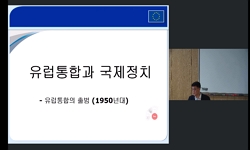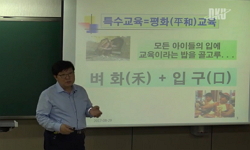This paper aims to examine why and how structural reforms of national universities in Japan took place in the 2000s. Even though they amount to about 10 percent of the entire higher education, they play a pivotal role in promoting advanced education a...
http://chineseinput.net/에서 pinyin(병음)방식으로 중국어를 변환할 수 있습니다.
변환된 중국어를 복사하여 사용하시면 됩니다.
- 中文 을 입력하시려면 zhongwen을 입력하시고 space를누르시면됩니다.
- 北京 을 입력하시려면 beijing을 입력하시고 space를 누르시면 됩니다.

2000년대 일본 국립대학 통합의 배경과 의미 = The Background and Significance of Merge in Japanese National Universities in the 2000s
한글로보기https://www.riss.kr/link?id=A107954311
- 저자
- 발행기관
- 학술지명
- 권호사항
-
발행연도
2021
-
작성언어
Korean
-
주제어
법인화 ; 국립대학 ; 통합 ; 지역 활성화 ; Incorporation ; National University ; Merge ; Local Revitalization
-
등재정보
KCI등재
-
자료형태
학술저널
- 발행기관 URL
-
수록면
111-141(31쪽)
-
KCI 피인용횟수
0
- DOI식별코드
- 제공처
- 소장기관
-
0
상세조회 -
0
다운로드
부가정보
다국어 초록 (Multilingual Abstract)
This paper aims to examine why and how structural reforms of national universities in Japan took place in the 2000s. Even though they amount to about 10 percent of the entire higher education, they play a pivotal role in promoting advanced education and research in graduate school and in offering an equal chance for higher education across the country. Due to structural transformations in Japanese society such as a decreasing number of student population, the increasing pressure for administrative reforms, and the spreading neoliberal ideology of accountability, however, all national universities changed into an independent administrative corporation, which led to the merge of 29 of 99 national universities from 2003 to 2007. The result was far fewer than the ministry of education expected, though. In addition, the structural reform did not contribute to improving the quality of education and research in the merged national universities. This resulted from the fact that the merge was implemented as part of administrative restructuring without sufficient consideration of its merits in education and research. It also derived from its failure to consider the significance of national universities in local communities. This case study suggests that we should not implement such broad structural reforms only to achieve the efficiency of governance in higher education. Instead, they should be carefully done by considering the role national universities play for local communities as well as by offering them proper financial support.
국문 초록 (Abstract)
이 논문은 전후(戰後) 큰 변화 없이 유지되어 온 일본의 국립대학 체제가 2000년대에 들어 급격하게 변화하게 된 배경과 그 의미를 고찰한다. 국립대학은 전체 대학 수에서 차지하는 비중은 ...
이 논문은 전후(戰後) 큰 변화 없이 유지되어 온 일본의 국립대학 체제가 2000년대에 들어 급격하게 변화하게 된 배경과 그 의미를 고찰한다. 국립대학은 전체 대학 수에서 차지하는 비중은 작지만, 대학원 교육과 연구 분야에서는 큰 몫을 차지할 뿐만 아니라, 지역 간 고등교육 기회의 격차를 줄이는 데도 중요한 역할을 한다. 그러나 학령기 인구감소, 행정개혁의 압력, 책무성 논리의 확산 속에, 2004년 국립대학이 일제히 법인화됐고, 이때 29개 국립대학의 통합이 이뤄졌다. 그러나 이것은 문부과학성이 기대한 것에 미치지 못하는 결과였고, 문부과학성이 통합을 통해 달성하고자했던 목표인 교육과 연구의 질적 향상도 이뤄지지 않았다. 이것은 국립대학 구조재편을 교육과 연구의 관점이 아니라 행정개혁의 하나로 추진했으며, 국립대학이 지역사회에서 차지하는 위상을 충분히 고려하지 않은 탓이었다. 그러므로 이 연구는 경쟁을 부추기는 식의 구조재편으로는 교육 및연구의 질적 향상을 이룰 수 없으며, 적절한 지원이 뒷받침되어야만 소기의 성과를 거둘 수 있다는 점을 시사한다.
참고문헌 (Reference)
1 요시미 슌야, "헤이세이 일본의 잃어버린 30년" 에이케이커뮤니케이션즈 2020
2 아마노 이쿠오, "제국대학" 산처럼 2017
3 김정은, "일본 국립대학법인화 배경의 정치학적 연구" 안암교육학회 14 (14): 153-180, 2008
4 김필동, "일본 국립대학 법인화의 과정과 구조" 사회과학연구소 19 (19): 1-30, 2008
5 根岸正光, "論文数·引用数からみたわが国の大学間格差の動向分析" 19 (19): 158-169, 2009
6 羽田貴史, "縮減期の高等教育政策: 大学統合·再編に関する一考察" 85 : 99-115, 2002
7 文部科学省, "私学助成に関する参考資料"
8 豊田長康, "法人化後15年、国立大学改革の現状と課題" 14 (14): 24-31, 2018
9 財務省, "日本の財政関係資料"
10 岩永雅也, "日本の教育改革" NHK出版 2015
1 요시미 슌야, "헤이세이 일본의 잃어버린 30년" 에이케이커뮤니케이션즈 2020
2 아마노 이쿠오, "제국대학" 산처럼 2017
3 김정은, "일본 국립대학법인화 배경의 정치학적 연구" 안암교육학회 14 (14): 153-180, 2008
4 김필동, "일본 국립대학 법인화의 과정과 구조" 사회과학연구소 19 (19): 1-30, 2008
5 根岸正光, "論文数·引用数からみたわが国の大学間格差の動向分析" 19 (19): 158-169, 2009
6 羽田貴史, "縮減期の高等教育政策: 大学統合·再編に関する一考察" 85 : 99-115, 2002
7 文部科学省, "私学助成に関する参考資料"
8 豊田長康, "法人化後15年、国立大学改革の現状と課題" 14 (14): 24-31, 2018
9 財務省, "日本の財政関係資料"
10 岩永雅也, "日本の教育改革" NHK出版 2015
11 財務省, "文教·科学技術(参考資料)"
12 文部科学省, "挑戦する国立大学"
13 羽田貴史, "戦後大学改革" 玉川大学出版部 1999
14 財務省, "平成の合併についての公表"
15 人事院, "平成30年度 年次報告書" 2019
16 文部科学省, "学校基本調査"
17 羽田貴史, "大学組織とガバナンス" 東信堂 2019
18 岩崎保道, "大学再編の動向に関する一考察" 68 : 85-90, 2019
19 文部科学省, "大学入学者選抜関連基礎資料集(その3)"
20 伊藤洋, "大学の統合・連携" 23-48, 2003
21 文部科学省, "大学(国立大学)の構造改革の方針"
22 木村誠, "地方国立大学の時代" 中公親書 2019
23 文部科学省, "国立大学法人運営費交付金を取り巻く現状について"
24 文部科学省, "国立大学法人運営費交付金の配分状況"
25 山﨑その, "国立大学法人における経営の効率性改善" 11 (11): 97-113, 2009
26 菅原千織, "国立大学の規模と範囲の経済性" 61 (61): 369-392, 2009
27 菅原千織, "国立大学の規模と範囲の経済性" 61 (61): 117-151, 2009
28 天野郁夫, "国立大学の構造改革" 81 : 50-59, 2002
29 北坂真一, "国立大学の効率性" 65 (65): 749-778, 2014
30 文部科学省, "国立大学の再編·統合の現状と今後の取り組み"
31 文部科学省, "国立大学の再編·統合についての基本的考え方(案)"
32 文部科学省, "国立大学の一法人複数大学制度等について"
33 本間政雄, "何のための国立大学の再編·統合か?" 14 (14): 2-9, 2019
34 文部科学省, "令和3年度学校基本調査(速報値)の公表について"
35 文部科学省, "令和2年度国立大学法人運営費交付金の重点支援の評価結果について: (別紙3)評価を反映した再配分の率"
36 中央教育審議会大学分科会将来構想部会, "今後の高等教育の将来像の提示に向けた中間まとめ"
37 日本経済団体連合会, "今後のわが国の大学改革のあり方に関する提言"
38 文部科学省, "中央教育審議会 大学分科会(第53回)議事次第[資料7-3] 大学の構造改革について"
39 Goodman, Roger, "Understanding University Reform in Japan through the Prism of the Social Sciences" 1 (1): 1-26, 2008
40 Eades, J. S., "The ‘Big Bang’ in Japanese Higher Education" Trans Pacific Press 2005
41 Kitamura, Kazuyuki, "The ‘Big Bang’ Theory and Japanese University Reform" 16 (16): 303-324, 1972
42 Goodman, Roger, "The Rapid Redrawing of Boundaries in Japanese Higher Education" 22 (22): 65-87, 2010
43 Amano, Ikuo, "The Origin of Japanese Credentialism (Japanese Mechanism of Education and Selection)" Trans Pacific Press 184-204, 2011
44 Choi, Jamyung, "The Hegemony of Tokyo Imperial University and the Paradox of Meritocracy in Modern Japan" 44 (44): 89-116, 2018
45 Harman, Grant, "Strategic Mergers of Strong Institutions to Enhance Competitive Advantage" 21 (21): 99-121, 2008
46 Christensen, Tom, "Japanese University Reform" 24 (24): 127-142, 2011
47 Inaba, Yushi, "Higher Education in a Depopulating Society" 15 (15): 136-157, 2020
48 Breaden, Jeremy, "Family-run Universities in Japan" Oxford University Press 2020
49 Okano, Kaori, "Education in Contemporary Japan" Cambridge University Press 1999
50 Huang, Futao, "Changes in Japanese Universities Governance Arrangements 1992–2017" 45 (45): 2063-2072, 2020
51 国立大学協会, "2019年国立大学法人基礎資料集"
52 文部科学省, "18歳人口の減少を踏まえた高等教育機関の規模と地域配置"
동일학술지(권/호) 다른 논문
-
미얀마 위기와 아세안 무용론?: 아세안의 제도적 진화와 그 함의
- 서울대학교 국제학연구소
- 배기현
- 2021
- KCI등재
-
- 서울대학교 국제학연구소
- 이왕휘
- 2021
- KCI등재
-
국제적 차원에서의 북한의 과학기술체제 구조에 대한 연구: 과학계량학 기법을 활용한 네트워크 분석을 중심으로
- 서울대학교 국제학연구소
- 윤정원
- 2021
- KCI등재
-
미국의 부동산 중개업의 변화: 온라인 부동산 정보 플랫폼을 중심으로
- 서울대학교 국제학연구소
- 이현송
- 2021
- KCI등재
분석정보
인용정보 인용지수 설명보기
학술지 이력
| 연월일 | 이력구분 | 이력상세 | 등재구분 |
|---|---|---|---|
| 2022 | 평가예정 | 재인증평가 신청대상 (재인증) | |
| 2019-01-01 | 평가 | 등재학술지 유지 (계속평가) |  |
| 2016-01-01 | 평가 | 등재학술지 선정 (계속평가) |  |
| 2015-12-01 | 평가 | 등재후보로 하락 (기타) |  |
| 2011-01-01 | 평가 | 등재 1차 FAIL (등재유지) |  |
| 2009-01-01 | 평가 | 등재학술지 유지 (등재유지) |  |
| 2007-01-01 | 평가 | 등재학술지 유지 (등재유지) |  |
| 2004-01-01 | 평가 | 등재학술지 선정 (등재후보2차) |  |
| 2003-01-01 | 평가 | 등재후보 1차 PASS (등재후보1차) |  |
| 2001-07-01 | 평가 | 등재후보학술지 선정 (신규평가) |  |
학술지 인용정보
| 기준연도 | WOS-KCI 통합IF(2년) | KCIF(2년) | KCIF(3년) |
|---|---|---|---|
| 2016 | 0.5 | 0.5 | 0.39 |
| KCIF(4년) | KCIF(5년) | 중심성지수(3년) | 즉시성지수 |
| 0.4 | 0.37 | 0.67 | 0.08 |




 KCI
KCI







